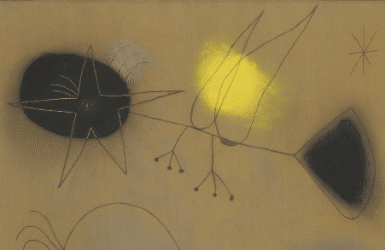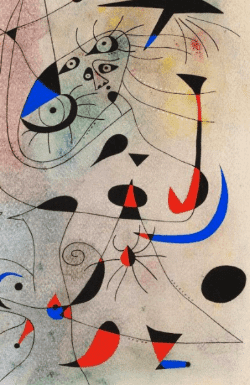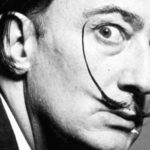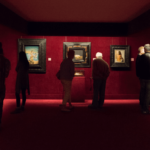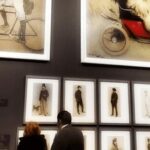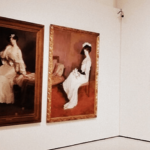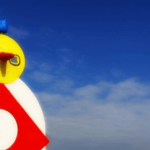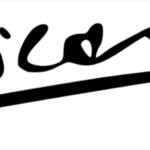Understanding Joan Miro Icons
MOST IMPORTANT JOAN MIRO SYMBOLS
Joan Miro was a prominent surrealist artist that lived between 1893 and 1983. And with any surrealist artist, in order to understand and enjoy his works you need to make a commitment. The laws of reality don’t apply to his artwork: it’s the artist who defines the rules of his own reality. The sooner you understand and accept the rules, the sooner (and the more!) you’ll have fun playing the game.
These are the icons in Miro you need to know about:
1
Hair
When presented with a painting that isn’t realistic, it is just natural to want to understand it. We read its title and try to find some clue that gives us a starting point. With Miro that can often be easy, since he uses a particular clue to identify people in his paintings. Or should I say “main characters”, rather than people, because you’ll see him doing that to birds or stars sometimes. Or to secondary characters as well. In Miro there are no strict rules…
And what he does is adding “hair”. Not a line representing a mane, but just three little traits in one side of what you need to interpret as the head (or the top of the character). Sometimes it’s 4 traits or more instead of 3, but who cares? Once you know how to find them, it doesn’t matter that much how many he depicted. It’s so much fun to be able to say “Hey, that’s where I need to start looking at the painting to read the story!”.
I chose “Figure in front of the Sun” to illustrate this point, because towards the end of his life Miro has become such a minimalist that the use of hair to tell us what is what is highly appreciated. But in the other points of this post you’ll find more examples. Actually all of the pictures in the post show hair except for the one I chose for birds.
2
Eyes and Feet
Miro is a surrealist artist that works from the freedom that the world of dreams confers him, but who still wants to stay connected to reality. His paintings are a balance between Earth and Sky, where the Earth represents reality and the Sky represents Dreams.
And there are two body parts that for him have the power to connect you to reality. Grounded to the Earth, feet represent your connection with the real world. Eyes must stay open to see what’s happening – as opposed to be closed when you sleep and dream.
This is why feet and eyes are body parts that stand out in many Joan Miro characters. And often there won’t be just a pair of each, like it’d be natural. There can be multiple of them, depending on the message Miro wants to convey, or the esthetic balance he’s trying to achieve.
I chose this double Self-Portrait that is really a statement of what the artist deems important as his art goes more and more minimal. In the background you’ll see an intricate self-portrait in pencil (actually a copy he commissioned before he sold the original). It was done in 1937, when his art was blooming with details and icons. Almost 30 years later, he took it and painted a second self-portrait on top of it to show how much his style had changed. Hair, feet and eyes – the essence – is all that’s left. It’s all that matters.
3
Stars and Planets
And whereas feet and eyes keep us connected to reality, what takes us to the dream world are the elements in the sky. The starry night, more often than the sun, that when appears is mostly during sunrise or sunset moments. Remember that the night is when we dream.
Joan Miro’s paintings are dotted with stars. Often just 3 traits crossing at the center (a childish star of 6 points). But sometimes it’s a more elaborate star with a precise perimeter. In such cases stars can become characters, and hence get hair. And they can even become part of some hybrid animal, like the bird in this fragment of “Woman, bird, stars“.
They can also be shooting stars, like the one at the top of the last image in the post (remember my warning at the top and don’t go there if you don’t want to read about women’s genitals in Miro). Sorry I had to crop it to stick to the format of the blog, but you’ll recognize two black and blue legs of a star with a hair-looking tail.
Planets are another common element in Miro’s skies. They can be just spots of color. Maybe the yellow behind the transparent wings of the bird? Or definitely the pink, blue and green stains in the self-portrait we discussed before. They are also often thick black dots, that can be connected with another one through a line. The line can be straight, or curved, or even zig-zag… Whatever he’s inspired to draw. You have examples in the bird below and in the featured image of this post.
4
Birds
Birds are the icons in Miro that connect reality and dream, because they can fly but they also touch the ground. Most of the time you’ll see them flying in the starry Mironian night, though.
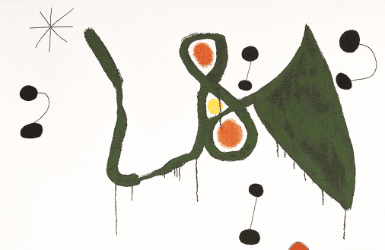
The evolution of birds in his art is quite interesting: from being shapes with recognizable wings and a beack, little by little they become simpler. Eventually they are simplified to lines representing the trajectory of the flight of that bird, rather than the animal itself.
The image I chose to illustrate this point is a fragment of Woman and Bird in the Night, and the bird here is still quite recognizable. You’ll find examples of line-birds in the featured image of this post, a fragment of Woman Dreaming of Scape: a thick blue line that sort of looks like the M of Miro and another think brown line with two legs. This last one was cropped from this post image for format purposes, though. There are also two very subtle line-birds in Figure in Front of the Sun (Point 1 – Hair).
5
Ladder of Scape
Joan Miro lived in a tumultuous period of history. The Spanish Civil War caught him in France, and was immediately followed by World War 2. Back to Spain he lived through a military dictatorship keeping a low profile.
Such events definitely took a toll in such a sensitive artist, who suffered a lot and used his art to evade from reality. Precisely ladders of scape are the Miro icons that express his need to scape from a world situation that is unbearable. They appear suspended in the air with the help of black planets, waiting to take us to a safer dream world.
In Naked Woman Going Upstairs, not only the ladder talks about this needs of leaving this reality, but also the woman body is deformed in a way that transmits nothing but suffering. You’ll see another ladder in Woman Dreaming of Scape (featured image of this post).
AND BONUS! The key to identify a woman in Joan Miro's art
6
Vaginas
Unlike Picasso, who was quite a playboy, Miro had a much more stable love life married to Pilar Juconsa since 1929. However, he paints women more often than men, and they are usually easy to recognize by their open sexes.
You’ll recognize them for being an ovoid or tear shape, often divided in two halves, often each half of a different color (preferably red and black, but as you already know, there are no strict rules in Miro). They sometimes have hear around them, like the vagina of the woman in Morning Star, illustrating this point.
Despite their shape, color and detail, Miro’s vaginas lack of the sexual pulse of Picasso’s paintings – each artist had clearly different interests.
You’ll find more examples in Woman Dreaming of Scape (featured image), Woman, Bird, Stars (Point 3 – Stars and Planets) and Woman and Bird in the Night (Point 4 – Birds). In Naked Woman Going Upstairs (Point 5 – Ladder of Scape), the she-monster’s vagina doesn’t follow this geometric pattern but does catch our attention since it has hair.
Learn more about Joan Miró:
CONCLUSION: This was a basic introduction to the fascinating world of Joan Miro symbols. With this you can start interpreting and enjoying the artist works, and I do encourage you to do more research to continue learning about his art. If you are interested in a tour of the Miro Foundation in Barcelona, let me know!
What are your favorite Miro icons?
Marta
MORE BARCELONA TIPS FOR YOU:
SHARE WITH YOUR TRAVEL MATES
RESEARCHING FOR A TRIP IS TIME-CONSUMING…
Need more inspiration?
Our 100% FREE Barcelona Collection will give you everything you need to organize the trip of your lifetime to Barcelona.
BEST INSIDER TIPS FROM THE PROS!

Last update on 2024-04-25 / Affiliate links / Images from Amazon Product Advertising API

